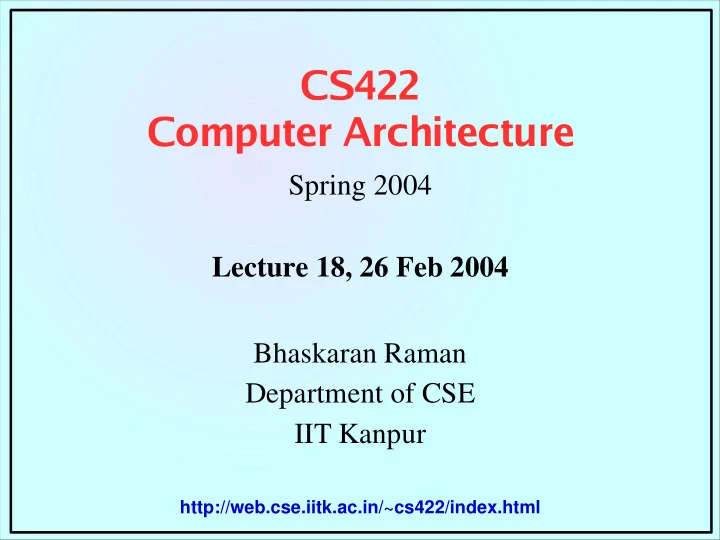

CS422 Computer Architecture Spring 2004 Lecture 18, 26 Feb 2004 Bhaskaran Raman Department of CSE IIT Kanpur http://web.cse.iitk.ac.in/~cs422/index.html
Memory Hierarchy ● Two principles: – Smaller is faster – Principle of locality ● Processor speed grows much faster than memory speed ● Registers – Cache – Memory – Disk – Upper level vs. lower level ● Cache design
Cache Design Questions ● Cache is arranged in terms of blocks – To take advantage of spatial locality ● Design choices: – Q1: block placement – where to place a block in upper level? – Q2: block identification – how to find a block in upper level? – Q3: block replacement – which block to replace on a miss? – Q4: write strategy – what happens on a write?
Block Placement: Fully Associative 0 8 11 Block 11 can go anywhere 16 Cache 24 Memory
Block Placement: Direct 0 8 Block 11 can 11 go only in block number 16 11 mod 8 Cache 24 Memory
Block Placement: Set Associative 0 8 Block 11 can 11 go in set number 16 11 mod 4 Cache 24 Memory
Continuum of Choices ● Memory has n blocks, cache has m blocks ● Fully associative is the same as set associative with one set ( m -way set associative) ● Direct placement is the same as 1-way set associative (with m sets) ● Most processors use direct, 2-way/4-way set associative
Block Identification ● How many different blocks of memory can be mapped (at different times) to a cache block? ● Fully associative: n ● Direct: n/m ● k-way set associative: k*n/m ● Each cache block has a tag saying which block of memory is currently present in it – A valid bit is set to 0 if no memory block is in the cache block currently
Block Identification (continued) ● How many bits for the tag? log 2 k ∗ n / m ● How many sets in cache? m / k ● How many bits to identify the correct set? log 2 m / k
Block Identification (continued) ● How many blocks in memory? n , log 2 n to represent block number in memory ● Given a memory address: Tag Index Block offset log 2 k log 2 n − log 2 m log 2 block-size log 2 m − log 2 k – Select set using index, block from set using tag – Select location from block using block offset – tag + index = block address
Block Replacement Policy ● Cache miss ==> bring block onto cache – What if no free block in set? – Need to replace a block ● Possible policies: – Random – Least-Recently Used (LRU) ● Lesser miss-rate, but harder to implement
Replacement Policy Performance 2-way LRU 2-way Random 4-way LRU 4-way Random 8-way LRU 8-way Random 16KB Cache size 64KB 256KB 0.00% 1.00% 2.00% 3.00% 4.00% 5.00% 6.00% Cache miss rate
Write Strategy ● Reads are dominant – All instructions are read – Even for data, loads dominate over stores ● Reads can be fast – Can read from multiple blocks while performing tag comparison – Cannot do the same with writes ● Should pay attention to write performance too!
When do Writes go to Memory? ● Write through: each write is mirrored to memory also – Easier to implement ● Write back: write to memory only when block is replaced – Faster writes – Some writes do not go to memory at all! – But, read miss may cause more delay ● Block being replaced has to be written back ● Optimize using dirty bit – Also, bad for multiprocessors and I/O
Write Stalls ● In write through, may have to stall waiting for write to complete – Called a write stall – Can employ a write buffer to enable the processor to proceed during the write-through
What to do on a Write Miss? ● Write-allocate (or, fetch on write): load block on a cache miss during a write ● No-write allocate (or, write around): just write directly to main memory ● Write-allocate usually goes with write-back, and no-write allocate goes with write-through
The Alpha AXP 21064 Cache ● 34-bit physical address – 29 bits for block address – 5 bits for block offset ● 8 KB cache, direct-mapped – 8 bits for index – 29 – 8 = 21 bits for tag
Steps in Memory Read ● Four steps: – Step-1: CPU puts out the address – Step-2: Index selection – Step-3: Tag comparison, read from data – Step-4: Data returned to CPU (assuming hit) ● This takes two cycles
Steps in Memory Write ● Write-through policy is used ● Write buffer with four entries – Each entry can have up to 4 words from the same block – Write merging: successive writes to the same block use the same write-buffer entry
Some More Details ● What happens on a miss? – Cache sends signal to CPU asking it to wait – No replacement policy required (direct mapped) – Write miss ==> write-around ● 8KB separate instruction cache
Separate versus Unified Cache ● Direct-mapped I-Cache D-Cache U-Cache cache, 32-byte 1KB 3.06% 24.61% 13.34% blocks, SPEC92, 2KB 2.26% 20.57% 9.78% on DECstation 4KB 1.78% 15.94% 7.24% 5000 8KB 1.10% 10.19% 4.57% ● Unified cache has 16KB 0.64% 6.47% 2.87% twice the size of I- 32KB 0.39% 4.82% 1.99% cache or D-cache 64KB 0.15% 3.77% 1.35% ● 75% instruction 128KB 0.02% 2.88% 0.95% references Miss-rates
Recommend
More recommend